Attitudes to Mental Health in Scotland: Scottish Social Attitudes Survey 2013
Report on public attitudes to mental health, based on data collected in the 2013 Scottish Social Attitudes Survey, and comparison with data collected through four previous surveys between 2002 and 2008.
This document is part of 2 collections
5 Public Attitudes Towards People Displaying the Symptoms of Schizophrenia and Depression
5.1 This chapter looks at attitudes towards two specific mental health problems and their symptoms. Scenarios describing someone with schizophrenia and someone with depression were given to each of the respondents. They were then asked what would be the best sources of help for each of them, how likely they would be to harm themselves or other people, and how willing they would be to interact with them in different situations. All respondents were given the same descriptions of two different scenarios: one about someone with schizophrenia and one about someone with depression. However, half the sample was told that the scenarios described someone with schizophrenia and someone with depression, and the other half were just told the scenario described someone with a mental health problem. Scenarios about people with different types of mental health problems were presented in the previous Well? surveys. However, the content of the scenarios was changed substantially between 2008 and 2013 so comparisons over time are not possible[46].
5.2 The two different introductions to the scenarios were as follows:
This card describes someone who has schizophrenia - please read through it or I can read it out if you prefer. I'd then like to ask you some questions about this person; or
This card describes someone who has a mental health problem - please read through it or I could read it out if you prefer…
The first scenario, as it appeared on the card, read:
Andy was doing pretty well until six months ago. But then things started to change. He thought that people around him were criticising him and talking behind his back. Andy heard voices even though no one else was around. These voices told him what to do and what to think. Andy couldn't work any more, stopped joining in with family activities and started to spend most of the day in his room.
A similar introduction was provided for the second scenario, using either the term 'depression' or a 'mental health problem'. The second scenario read:
Stephen has been feeling really down for about six months and his family have noticed that he hasn't been himself. He doesn't enjoy things the way he normally would. He wakes up early in the morning with a flat heavy feeling that stays with him all day long. He has to force himself to get through the day, and even the smallest things seem hard to do. He finds it hard to concentrate on anything and has no energy.
5.3 Nine questions were asked following each scenario:
- Say it was possible for Andy/Stephen to get help from some people or other sources. Which of the following would be the best three sources of help? (from a list of nine options)
- In your opinion, how likely, or unlikely, is it that Andy/Stephen would do something harmful or violent to…
- …himself?
- …other people?
- How willing, or unwilling, would you be to …
- …move next door to Andy/Stephen?
- …spend an evening socialising with Andy/Stephen?
- …make friends with Andy/Stephen?
- …have Andy/Stephen as a workmate or colleague?
- …have Andy/Stephen marry into the family?
- …have Andy/Stephen provide childcare for someone in your family?
5.4 The scenarios were intended to encourage the respondent to think about a person, rather than just 'a label'. Including a specific diagnostic label in the introductions for half the sample tested whether there was any reaction to the labels.
Approach to analysis
5.5 The analysis has been divided into three sections. The first looks at responses to the question about the best sources of help, the second at responses to the questions about the likelihood of causing harm, and the third at responses to the questions on willingness to interact with the people in the scenarios.
5.6 Attitudes to schizophrenia and attitudes to depression have mostly been considered separately. In the section on willingness to interact, we also examined the extent to which individual respondents held the same or different attitudes to people with schizophrenia or depression.
5.7 Most of the analysis combined the views of those given a label for the condition described and those who were not, as there were no significant differences in the attitudes to these two groups. Where there were significant differences between responses from the two groups, these are discussed.
5.8 How attitudes varied between sub-groups was explored in relation to socio-demographic factors, area level factors, mental health experience and social attitudes. This analysis was conducted using the same factors as in the previous chapter[47], with the following amendments:
- Measures of trust, community support and attitudes to ethnic diversity were not considered in relation to the questions on sources of help
- Whether the respondent personally knew anyone close who has had schizophrenia was used to analyse responses to the questions about the person with schizophrenia
- Whether the respondent personally knew anyone close who has had depression, and whether the respondent had experienced depression themselves, were used to analyse responses to the questions following the scenario about depression
5.9 Important sub-group differences have been highlighted in the text, with more detailed tables in Annex A. Again, important differences were determined through a combination of tests of statistical significance and regression analysis.
Sources of help
5.10 The most commonly mentioned source of help deemed appropriate for someone with the symptoms of schizophrenia, was a specialist mental health professional (86%), followed by a family doctor (70%) and a family member (62%) (Figure 5.1 below). Around a third of people (34%) mentioned all three of these[48]. The other answer options were chosen by less than a third. The same three categories also dominated responses for the scenario describing someone with the symptoms of depression. However, it is interesting that for someone with depression the most commonly mentioned category was family doctor (77%), followed by the specialist mental health professional (67%) and a family member (65%). Over a quarter (28%) chose these as their top three sources.
5.11 The difference between responses to the two scenarios showed that more people recognised that the person with schizophrenia had a need for specialist involvement. Around twice as many people mentioned help from a friend or neighbour for the person with depression (21%, compared with 11%). While there was an expectation that family members may take on some of the responsibility for providing support for people with both schizophrenia or depression, that expectation was rarely extended to friends or neighbours in the case of schizophrenia. Self-help methods were very rarely mentioned as one of the three best sources of help for either scenario (Figure 5.1 below).
Figure 5.1: Three best sources of help for someone with schizophrenia or depression (2013)
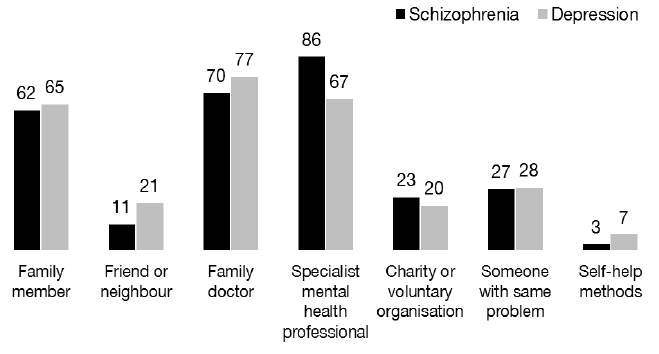
Base: all respondents
Sample size: 1,497
Named and unnamed conditions and suggested sources of help
5.12 When responses to the scenarios were considered according to whether respondents were given a label in addition to the symptoms, there were very few differences, suggesting people generally recognised the nature of these conditions, even if they did not know what the conditions actually were. One difference of note was that when presented only with the symptoms of schizophrenia, 73% mentioned the family doctor as one of the best sources of help. When the term schizophrenia was also mentioned, only 67% mentioned the doctor.
How views on suggested sources of help for someone with schizophrenia and someone with depression varied between sub-groups
5.13 Views on the best sources of help varied by age group, whether people knew someone with a mental health problem and their own personal experience of mental health problems. The youngest age group (18 to 24 years old) were considerably more likely than other age groups to mention family members and someone with the same problem as sources of help both for those with schizophrenia and for those with depression. To a lesser degree this group were also more likely to mention friends and neighbours as a source of help and they were less likely to mention seeking help from a family doctor in both cases. The youngest age group were also more likely to suggest self-help methods as a source of help for someone with depression.
5.14 Those who knew someone with a mental health problem were more likely than those who did not to mention help from a specialist health professional and help from a charity or voluntary organisation for someone with schizophrenia (89% compared with 80% for the specialist health professional and 25% compared with 19% for the charity). Those who had ever personally experienced depression were slightly more likely than those who had not to suggest self-help methods as a source of help for those with depression (11% compared with 6%).
Likelihood of harming self or others
5.15 Respondents were asked how likely it was that those described in the scenarios would do something harmful or violent to themselves or to others. It is possible that a wide range of types of harm or violence may have been considered by respondents in giving their answers.
5.16 Almost three-quarters (73%) of people thought that the person with symptoms of schizophrenia was likely to harm themselves (Figure 5.2 below). People with schizophrenia are indeed more at risk of self-harm than others, with around half of this group self-harming at some time in their life (NICE, 2012). Approximately 5% of people diagnosed with schizophrenia die by suicide (Hor et al, 2010), with around one in five suicides in those aged under 35 being attributed to schizophrenia (Appleby et al, 2014).
Figure 5.2: Likelihood of someone showing the symptoms of schizophrenia or the symptoms of depression harming themselves or others (2013)
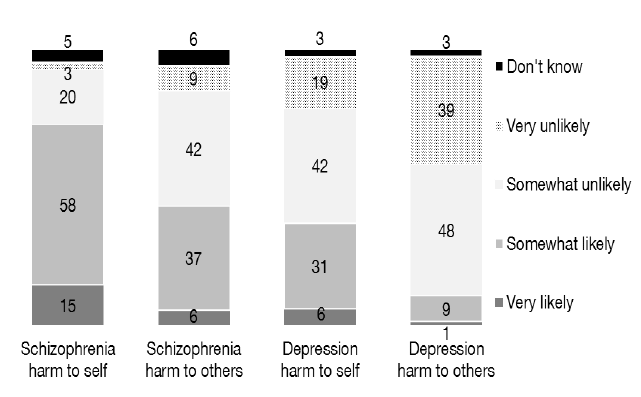
Base: all respondents
Sample size: 1,497
5.17 Depression is also associated with suicidal thoughts and self-harm, although the risk of serious harm is smaller than for someone with schizophrenia. More than two-thirds of those attending an accident and emergency department at a hospital for self-harm would meet the criteria for being diagnosed with depression at the time they are assessed (NICE, 2012). Thirty-seven percent thought that the person with symptoms of depression was likely to harm themselves, demonstrating that overall people believe that someone with depression was less likely to harm themselves than someone with schizophrenia (Figure 5.2 above).
5.18 More than two-fifths (43%) thought that the person with schizophrenia was likely to do something harmful or violent to others. One in ten thought that the person with depression was likely to do something harmful to others (Figure 5.2 above).
How views on likelihood of someone with schizophrenia harming others varied between sub-groups
5.19 The strongest predictor of whether people thought someone with schizophrenia was likely to harm other people was the measure of attitudes to diversity. Forty-eight percent of those who agreed that Scotland would lose its identity if there were increased immigration from specific groups said it was likely that someone with schizophrenia would harm someone else, compared with 40% of those who disagreed. This matches what was found in the previous chapter with respect to the statements that 'people with mental health problems are often dangerous' and the 'public should be better protected from people with mental health problems' (Paras 4.34 and 4.38). Such attitudes did not predict whether people thought someone with depression would harm others.
5.20 The only other significant factor associated with the likelihood of someone with schizophrenia harming others was whether the respondent knew anyone close to them with schizophrenia. One lay perception might be that a lack of knowledge could increase someone's views of the likelihood of someone with schizophrenia causing harm to others. However, it was actually those who knew someone with schizophrenia who were more likely to think someone with schizophrenia would harm someone else (55% of those who knew someone with schizophrenia compared with 42% of those who did not).
How views on likelihood of someone with schizophrenia harming themself varied between sub-groups
5.21 People's views on ethnic diversity were also a predictor of whether they thought someone with schizophrenia was likely to harm themselves (76% of those who agreed that Scotland would lose its identity with increased immigration said it was likely compared with 68% of those who disagreed). Other factors associated with thinking someone with schizophrenia was likely to harm themselves included gender (women were more likely than men to think this); income (those on middle incomes were the most likely to think this); urban-rural (those in remote rural areas were the least likely to think this); and trust (those who generally thought that 'most people can be trusted' were less likely to think someone with schizophrenia would harm themselves).
How views on the likelihood of someone with depression harming others varied between sub-groups
5.22 Those who had personally experienced depression, or knew someone who had experienced depression, were less likely to think that someone with depression would harm someone else (7% of both those with personal and indirect experience of depression, compared with 11% of those who had not personally experienced depression, and 15% of those who did not know anyone who had). People who were generally trusting were also less likely to think that someone with depression would do something harmful to others.
How views on the likelihood of someone with depression harming themself varied between sub-groups
5.23 Younger people were the most likely to think someone with depression would harm themselves. Sixty-one percent of those aged 18 to 24 and 40% of those aged 25 to 34 thought that someone with depression was likely to harm themself, compared with 28% to 35% of those in the older age groups. This may be a reflection of the fact that self-harm is much more prevalent in young adults and adolescents (Nock, 2010) and therefore awareness of self-harm may be higher among these age groups. Those who were less trusting of others in general[49] were also more likely to think that someone with depression would harm themselves.
Willingness to interact with someone with schizophrenia
5.24 A set of six questions linked to each of the scenarios asked about people's willingness to interact in a range of situations[50] with the person depicted. More than one in five (22%) were not willing to interact with someone with schizophrenia in any of the ways mentioned, while only 8% were willing to interact in all the different ways.
5.25 Around two thirds of people said they were willing to make friends with someone with schizophrenia (66%) and a slightly smaller proportion were willing to spend an evening socialising with someone with schizophrenia (59%). Around half (49%) said they were willing to move next door to someone with schizophrenia, a third were willing to have them marry into their family (33%), but only one in ten were willing to have them provide childcare for someone in their family (10%) (see Figure 5.3 below).
5.26 Respondents were also asked about work situations. Someone with schizophrenia is covered under the Equality Act 2010 and any discrimination at work because of this illness would be considered illegal. Around-two thirds of people said they were willing to have someone with schizophrenia as a work colleague (64%). However, one in seven (14%) said they would be unwilling to have someone with schizophrenia as a work colleague.
5.27 Responses to these questions were highly correlated. In general, for those who said they were willing for someone with schizophrenia to provide child care for someone in their family, they were also willing for them to marry into the family. Similarly, if they were willing for someone with schizophrenia to marry into the family, they also tended to be willing to make friends with, socialise with, move next door to someone with schizophrenia and to have them as a work colleague.
Figure 5.3: Willingness to interact with someone showing symptoms of schizophrenia (2013)
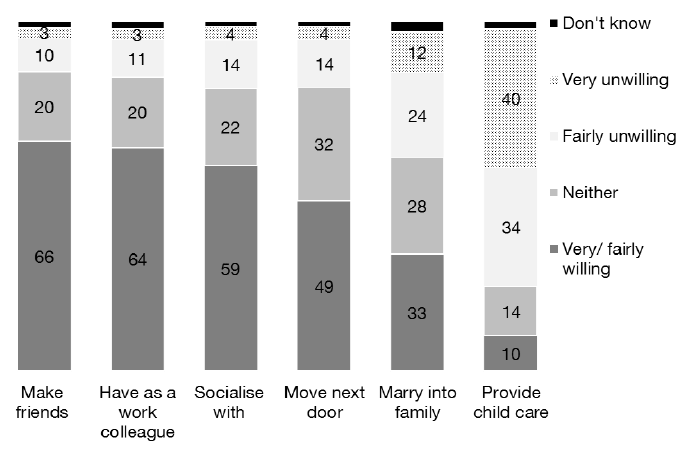
Don't know was chosen by 3% or less in each category.
Base: all respondents
Sample size: 1,497
Willingness to interact with someone with depression
5.28 Responses to the questions on willingness to interact with someone with depression were even more highly correlated than they were for someone with schizophrenia. Nearly everyone who was willing for someone with depression to provide child care for someone in their family was also willing for them to marry into the family. And nearly everyone who was willing for them to marry into the family was willing to interact in all four of the other ways. Twenty percent were willing to interact with someone with depression in all of the ways mentioned and 15% in none of these situations.
Figure 5.4: Willingness to interact with someone showing symptoms of depression (2013)
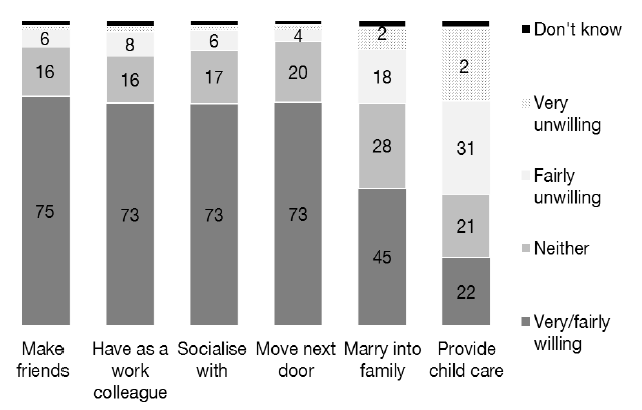
Don't know was chosen by 2% in each category.
Base: all respondents
Sample size: 1,497
5.29 Around three quarters said they were willing to make friends with someone with depression, to have them as a work colleague, to socialise with them, and to move next door to them (Figure 5.4 above). However, fewer than half said they were willing to have someone with depression marry into the family, and a fifth said they were unwilling for someone with depression to marry into their family. Given the fact that around 50% of people knew someone with depression, as discussed in Chapter 2 (see Para 2.5), these figures show quite high levels of discrimination where it would not necessarily be expected. Less than a quarter of people said they would be willing to have someone with depression provide childcare (23%).
How willingness to interact with someone with schizophrenia varied between sub-groups
5.30 Given the high correlation between the different types of interaction, it is not surprising to find the same factors tended to be associated with responses to each of the questions. Women were more likely than men to say they would be willing to make friends with someone with schizophrenia, have them as a work colleague, socialise with them, move next door to them, and have them marry into the family. Older people, the self-employed, those who did not know anyone with a mental health problem, those who had not personally experienced a mental health problem, and those who said increased immigration would affect Scotland's identity, also tended to be less willing to interact in each of these ways.
5.31 However, the question on whether people were willing for someone with schizophrenia to provide childcare did show a different pattern of responses. Knowing someone close to you with schizophrenia was the only significant factor associated with being willing to have someone with schizophrenia provide childcare[51]. One in five who knew someone with schizophrenia (19%) said they would be willing to have someone with schizophrenia provide childcare, compared with around one in ten (9%) who did not.
How willingness to interact with someone with depression varied between sub-groups
5.32 Gender, age, income and knowing someone with a mental health problem were associated with willingness to interact with someone with depression. Women and those who knew someone with a mental health problem were more likely to say they would be willing to move next door to someone with depression, to spend an evening socialising with them, to make friends with them, to have them as a work colleague, and to have them marry into the family. Those aged 65 or above and those on lower incomes were less willing to do each of these things[52].
5.33 Again, the question about childcare was slightly different, with the only significant factors being age and general trust in others[53]. Only 11% of those aged 65 and above said they would be willing to have someone with depression provide childcare, compared with nearly a third of those aged 18 to 34. Those who thought that most people can be trusted were more likely to say they would be willing to have someone with depression provide childcare: 26% of those who thought most people can be trusted compared with 14% of those who thought 'you can't be too careful in dealing with people'[54].
Named and unnamed conditions and willingness to interact
5.34 There were few differences according to whether the condition was named in the scenario, suggesting the terms 'schizophrenia' and 'depression' tend not to add to stigmatisation of those with these mental health problems. The only difference of note, that may be of concern in a workplace environment, was that those who were told that the person had schizophrenia were more likely to be unwilling to have them as a work colleague (17%) compared with 12% of those who were only told the symptoms (see Figure 5.5 below).
Figure 5.5: Willingness to have someone with schizophrenia as a work colleague by whether told only symptoms, or that they had schizophrenia (2013)
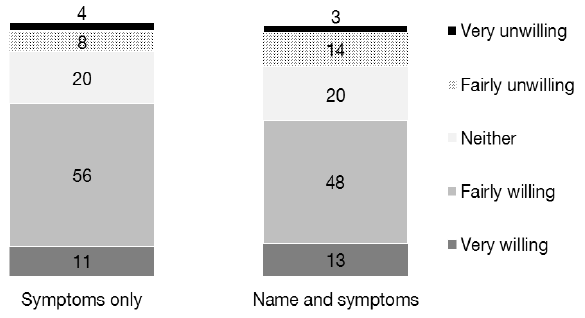
Don't know was chosen by 3% or less in each category.
Base: all respondents
Sample size: 759 (symptoms only); 738 (name and symptoms)
Attitudes towards both schizophrenia and depression
5.35 It might be expected that those who held negative attitudes towards the person with symptoms of depression would also hold negative attitudes towards the person with symptoms of schizophrenia, but this was not always the case.
5.36 Figure 5.6 (below) shows that between 16% and 20% of people were unwilling to interact with either or both those with depression or schizophrenia in relation to making friends, having them as a work colleague, socialising with them, or moving next door. About 40% were unwilling for either or both to marry into the family and 76% were unwilling to have them provide childcare. Between 2% and 4% of people said they were unwilling to interact with someone with depression, in each of the ways mentioned, but were not unwilling to interact with someone with schizophrenia.
5.37 In the situations where most people were willing to interact with either someone with schizophrenia or depression, the proportion who were unwilling to interact with someone with depression but were willing to interact with someone with schizophrenia were high. At least a third of those who were unwilling to make friends with someone with depression were not unwilling to make friends with the person with schizophrenia. The same is true for having them as work colleagues, socialising with them and moving next door to them. The reasons for this are not clear, but may partly be an artefact of the small numbers involved.
Figure 5.6: Whether unwilling to interact with someone with schizophrenia and someone with depression
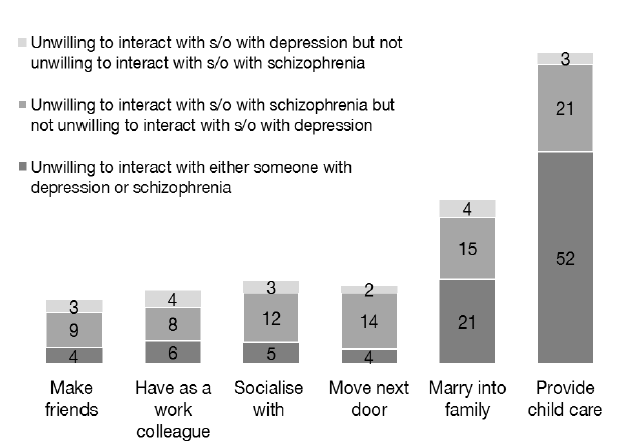
Base: all respondents
Sample size: 1,497
Contact
Email: Fiona MacDonald
There is a problem
Thanks for your feedback